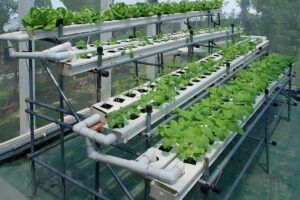Unlocking the potential of hydroponics and bringing it into the comfort of our own homes has revolutionized the way we cultivate plants. As we delve into this futuristic yet efficient method of gardening, it is only natural to face a few hiccups along the way. Fear not! For every challenge encountered in our hydroponic journey, there lies a solution waiting to be discovered. In this article, we will embark on a troubleshooting adventure, uncovering the secrets to resolving home hydroponic problems and ensuring the flourishing growth of our green companions. So, put on your gardening gloves and get ready to navigate the twists and turns of this hydroponic maze as we pave the path towards verdant success.
1. Diagnosing Common Issues in Home Hydroponics: Identifying the Culprits Behind Unhealthy Growth
When it comes to home hydroponics, achieving healthy growth is the ultimate goal. However, sometimes our plants don’t thrive as expected, and it can be frustrating to pinpoint the cause. In this post, we will explore common issues that may be hindering your hydroponic garden’s health and provide solutions to help you troubleshoot and address these problems.
1. Nutrient Deficiencies:
One of the most common culprits behind unhealthy growth in hydroponics is nutrient deficiencies. Plants rely on a precise balance of nutrients to thrive, and when they’re lacking certain elements, it can lead to stunted growth, yellowing leaves, and overall poor health. To diagnose this issue, look out for these signs:
- Yellowing leaves, especially at the tips or between veins
- Poor root development
- Slow growth or lack of growth
If you notice any of these symptoms, it’s crucial to address nutrient deficiencies promptly. Consider adjusting your nutrient solution to ensure it contains the right balance of essential elements like nitrogen, phosphorus, and potassium. Regularly check and adjust the pH levels as well, as improper pH can affect nutrient absorption.
2. Inadequate Lighting:
Another factor that can greatly impact the health of your hydroponic plants is inadequate lighting. Without sufficient light, plants struggle to photosynthesize, leading to weak growth and spindly stems. Signs of inadequate lighting include:
- Long, stretched stems
- Pale or yellowish leaves
- Small or no flowers/fruits
To rectify this issue, assess your lighting setup. Ensure that your plants are receiving the right intensity and duration of light suitable for their growth stage. Consider investing in high-quality grow lights or adjusting the distance between the lights and plants to achieve optimum light levels.
2. Optimizing Nutrient Solutions: Ensuring Adequate Plant Nutrition for Vibrant Hydroponic Systems
In order to achieve healthy growth in your home hydroponic system, it is crucial to optimize the nutrient solutions for adequate plant nutrition. Without proper nourishment, plants may struggle to thrive and display vibrant growth. Here are some key strategies for troubleshooting common nutrient-related problems and ensuring the overall health of your hydroponic plants:
- Understanding plant nutrient requirements: Different plants have varying nutrient needs, and it is essential to familiarize yourself with the specific requirements of the crops you are growing hydroponically. Conduct thorough research or consult gardening experts to determine the ideal nutrient composition, including the balance of macronutrients (such as nitrogen, phosphorus, and potassium) and micronutrients (such as iron, manganese, and zinc). By providing the right nutrients in the right amounts, you can prevent deficiencies or excesses that could stunt plant growth.
- Regular monitoring and adjustment: It is crucial to regularly monitor the nutrient levels in your hydroponic system. This can be achieved through regular testing of the nutrient solution using kits or meters designed for hydroponics. By conducting routine checks, you can identify any imbalances or deficiencies early on and make necessary adjustments. Keep in mind that factors like plant growth stage, water quality, and environmental conditions can influence nutrient uptake, so periodic recalibration may be needed to maintain optimal nutrition.
- Implementing a feeding schedule: Establishing a consistent feeding schedule can greatly contribute to the health and vitality of your hydroponic plants. This involves providing nutrients at specific intervals and in appropriate quantities. Many hydroponic systems utilize a recirculating nutrient solution, which requires regular checks and replenishment to ensure a constant supply of nutrients. Monitor plant growth, response, and even leaf color to refine your feeding schedule over time and deliver a well-balanced nutrient solution for your plants’ needs.
By focusing on optimizing nutrient solutions and addressing any potential issues promptly, you can ensure that your hydroponic plants receive the necessary nutrients for vibrant and healthy growth. Remember to always prioritize proper research and periodic monitoring to maintain an optimal balance of nutrients and support the overall success of your home hydroponic system.
3. Mastering Light and Temperature Control: Creating the Ideal Growing Environment for Healthy Hydroponic Plants
In order to ensure healthy growth of your hydroponic plants, mastering light and temperature control is crucial. Creating the ideal growing environment requires careful attention to the following factors:
- Lighting: Providing sufficient light is essential for photosynthesis and promoting lush plant growth. Make sure to position your grow lights at an appropriate distance from the plants to avoid burning or stunting them. Different plant species have varying light requirements, so research each plant’s needs and adjust the lighting accordingly.
- Temperature: Maintaining the right temperature helps optimize plant growth and metabolic processes. Hydroponic systems are often situated indoors, so control the ambient temperature to avoid extreme fluctuations. Most plants thrive within a temperature range of 65-80°F (18-27°C). Use a digital thermometer to monitor and adjust the temperature as necessary.
- Ventilation: Proper airflow is crucial for healthy hydroponic plants. Invest in a small fan to ensure adequate ventilation within your grow space. This helps control temperature, discourages the growth of molds and pests, and promotes even distribution of carbon dioxide. Open vents or windows periodically to allow fresh air to circulate, but be mindful of any potential influx of pests or pollutants.
4. Managing pH and EC Levels: Balancing Water Quality for Optimal Hydroponic Growth
When it comes to hydroponic gardening at home, managing pH and EC levels is crucial for ensuring healthy and vigorous plant growth. pH, which stands for potential of hydrogen, refers to the acidity or alkalinity of the water. Maintaining the optimal pH range of 5.5 to 6.5 is essential for nutrient absorption by the plant roots. On the other hand, EC, which stands for electrical conductivity, measures the concentration of dissolved salts in the water. By monitoring and regulating these two factors, you can create an environment that promotes optimal nutrient uptake, leading to vibrant plants and abundant yields.
To manage pH levels effectively, there are several solutions you can consider. One popular method is using pH buffers, which help maintain a stable pH by neutralizing any fluctuations. These buffers are available in powder or liquid form and can be added directly to the nutrient solution. Additionally, regularly testing the pH using a pH meter or testing kit will allow you to detect any imbalances and take corrective action promptly. Adjusting the pH by adding small amounts of pH-up or pH-down solutions, depending on the requirements, will help bring it back within the desired range.
Alongside pH management, maintaining the appropriate EC levels in your hydroponic system is equally important for optimal plant growth. Excessive salt concentration can hinder nutrient absorption by the roots, leading to stunted growth and nutrient deficiencies. It’s essential to regularly monitor and adjust the EC levels using a reliable EC meter, ensuring it stays within the recommended range for your chosen plant varieties. If the EC is too high, diluting the nutrient solution with fresh water can rectify the issue. Conversely, if the EC is too low, adding nutrient solution or adjusting the nutrient strength will help bring it up to the desired level.
5. Preventing Pest and Disease Infestations: Implementing Effective Strategies for Disease-Free Hydroponic Gardens
1. Maintain cleanliness:
- Regularly clean and sanitize your hydroponic system to remove any potential sources of diseases or pests.
- Keep the growing area free from debris, fallen leaves, and dead plant material, as these can attract pests and harbor diseases.
- Disinfect all tools, equipment, and containers before and after use to prevent the spread of pathogens.
2. Implement proper ventilation:
- Ensure adequate air circulation by installing fans or ventilation systems in your hydroponic garden. Good ventilation helps maintain optimal temperature and humidity levels, preventing the development of mold, fungi, and other diseases.
- Monitor and control humidity levels to discourage the growth of pathogens. Use a dehumidifier if necessary.
3. Practice integrated pest management:
- Regularly inspect your plants for signs of pests, such as holes in leaves, drooping, or wilting.
- Use beneficial insects, such as ladybugs or predatory mites, to naturally control pest populations.
- If chemical control is necessary, choose organic and safe pesticides, and apply them sparingly and according to the manufacturer’s instructions.
As we draw the curtains on this hydroponic troubleshooting saga, we hope to have shed light on the myriad obstacles and triumphs that surround the world of modern gardening. Like a symphony, the dance between plants and their caregiver is an intricate balance of patience, knowledge, and determination.
By now, you should feel armed with an arsenal of problem-solving techniques, enabling you to combat any hindrance that may arise within your hydroponic oasis. Remember, the journey to bountiful harvests is not without its hurdles, but with a touch of creativity and an unwavering dedication, you will prevail.
The scent of success hangs in the air as you stand at the precipice of your flourishing hydroponic haven. As you marvel at the verdant beauty that surrounds you, let these words serve as a gentle reminder: never fear the challenges that may come your way. Instead, embrace them as opportunities to learn, to adapt, and to fine-tune your horticultural prowess.
In this delightful dance of water, nutrients, and ingenuity, every setback brings you one step closer to becoming a master of your green realm. Troubleshooting is not merely a task; it is a rite of passage, a necessary pilgrimage on your journey to a fruitful and fulfilling hydroponic experience.
Now, armed with an array of comprehensive solutions, you can confidently tackle any problem that threatens to overshadow your gardening aspirations. Armed with knowledge, you possess the power not only to cultivate a thriving hydroponic environment but also to cultivate an inner strength that accompanies all endeavors in life.
In the end, as the sunlight filters through the lush foliage and dances upon your joyful countenance, you will celebrate the boundless potential of hydroponics. Remember, the secret to a prosperous hydroponic garden lies not only in solving problems but also in realizing that the solutions often lie within yourself.
So, dear gardener, take these words to heart as you embark on your hydroponic journey. Embrace the challenges, embrace the triumphs, and embrace the unrivaled satisfaction that comes with nurturing life from within the confines of your humble abode.
Until we meet again, may your hydroponic adventures be filled with resounding success and boundless satisfaction. Happy growing!



